Amiga E is a programming language created by Wouter van Oortmerssen on the Amiga computer. The work on the language started in 1991 and was first released in 1993. The original incarnation of Amiga E was being developed until 1997, when the popularity of the Amiga platform dropped significantly after the bankruptcy of Amiga intellectual property owner Escom AG.

Descent: FreeSpace – The Great War, known as Conflict: FreeSpace – The Great War in Europe, is a 1998 space combat simulation IBM PC compatible computer game developed by Volition, when it was split off from Parallax Software, and published by Interplay Productions. In 2001, it was ported to the Amiga platform as FreeSpace: The Great War by Hyperion Entertainment. The game places players in the role of a human pilot, who operates in several classes of starfighter and combats against opposing forces, either human or alien, in various space-faring environments, such as in orbit above a planet or within an asteroid belt. The story of the game's single player campaign focuses on a war in the 24th century between two factions, one human and the other alien, that is interrupted in its fourteenth year by the arrival of an enigmatic and militant alien race, whose genocidal advance forces the two sides into a ceasefire in order to work together to halt the threat.

Tyrian is a vertically scrolling shooter developed by Eclipse Software for MS-DOS and published in 1995 by Epic MegaGames. Tyrian was programmed by Jason Emery, illustrated by Daniel Cook, and its music composed by Alexander Brandon and Andras Molnar. The game was re-released as freeware in 2004. A free and open-source port of the game started in April 2007.
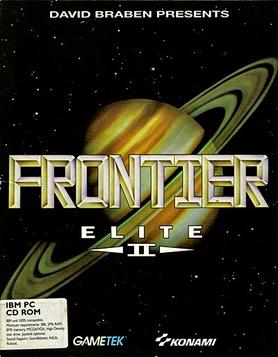
Frontier: Elite II is a space trading and combat simulator video game written by David Braben and published by GameTek and Konami in October 1993 and released on the Amiga, Atari ST and DOS. It is the first sequel to the seminal game Elite from 1984.
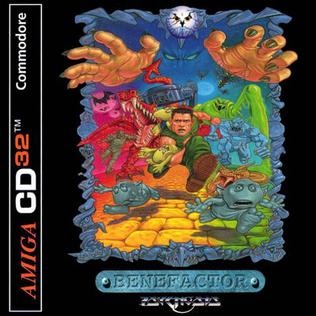
Benefactor is a video game for the Amiga developed by the Swedish team Digital Illusions CE (DICE) and published in 1994 by Psygnosis.

Star Goose is a vertically scrolling shooter that was published for the Amiga, Atari ST, and MS-DOS by Logotron in 1988. The player controls Scouser-Gitt, who pilots the eponymous Star Goose, a vessel that has been commissioned to scour the planet Nom and collect 48 crystals. Players must collect all six crystals in each of the game's eight levels to advance, while at the same time avoiding or destroying enemies and maintaining their shield, ammunition, and fuel levels. The game's surfaces are contoured, which affects the way that bullets travel, and contain tunnels that switch modes to a three-dimensional perspective where the player can replenish their resources.
Aminet is the world's largest archive of Amiga-related software and files. Aminet was originally hosted by several universities' FTP sites, and is now available on CD-ROM and on the web. According to Aminet, as of 3 September 2022, it has 83930 packages online.

Awesome is a science fiction action video game released by Psygnosis for the Amiga in 1990. It features a variety of gameplay styles, from overhead shooting to Asteroids-esque sequences, and a pre-rendered ray-traced intro. The objective is to traverse the galaxy despite not having funds or fuel to do it.
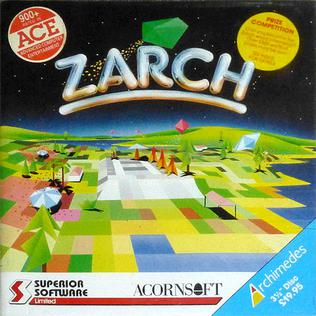
Zarch is a computer game developed by David Braben in 1987, for the release of the Acorn Archimedes computer. Zarch started off as a demo called Lander which was bundled with almost all releases of the Acorn Archimedes.

Gravity Force is a video game series for the Amiga. The first game in the series was published commercially by Kingsoft GmbH in 1989, as a Thrust-clone. The aim is to pilot a spacecraft through caverns avoiding enemy fire. The ship is subject to gravity and inertia and colliding with terrain or the walls of the cave results in destruction of the ship.
XTreme Racing is a kart-style racing video game released in 1995 for the Amiga. The gameplay is heavily based on Super Mario Kart, released for the Super NES three years prior. Players select from one of 8 possible characters, each driving unique vehicles.

Sub-Terrania is a 1994 multidirectional shooter developed by Danish studio Zyrinx and published by Sega for the Mega Drive/Genesis. The game takes place in the future, where a deep-space mining colony has been invaded by an unknown alien race. The player assumes the role of a lone pilot who must defeat the alien forces and rescue the trapped miners. During the course of the game, the player controls a rotatable craft with thrusters that is constantly subject to gravity and the craft's inertia. Using the ship's "rotate-and-thrust" capabilities, the players must aim, shoot, dodge and carefully maneuver their way through the hazardous landscape while constantly taking gravity and refueling needs into account.
Amiga software is computer software engineered to run on the Amiga personal computer. Amiga software covers many applications, including productivity, digital art, games, commercial, freeware and hobbyist products. The market was active in the late 1980s and early 1990s but then dwindled. Most Amiga products were originally created directly for the Amiga computer, and were not ported from other platforms.
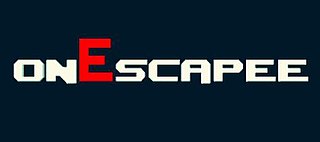
OnEscapee is an action-adventure video game, released for the Amiga in 1997. Invictus re-released the software in 2004 as freeware for Microsoft Windows to coincide with the 10th anniversary of the company's founding.
Scorched Tanks is an artillery style game released for the Amiga platform in 1994. The game is inspired by the MS-DOS game Scorched Earth (1991).

Oids is a multidirectional shooter developed and self-published by FTL Games in 1987. The game was originally released on the Atari ST, followed by a B&W version for the classic 68k Macintosh in 1990. The Atari ST version, written by Dan Hewitt, was a cult favourite in the UK, where it received rave reviews.

Space Gun is a 1990 first-person shooter arcade game released by Taito. The game is set aboard a crippled space station that has been overrun by hostile alien creatures. The objective is to rescue human crew members while destroying the alien creatures. The game lets the player shoot limbs off the creatures, resulting in blood splatters.
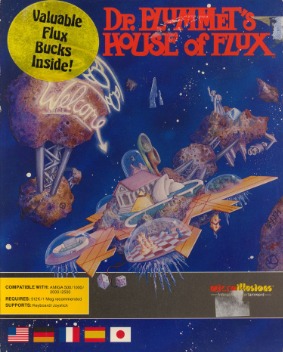
Dr. Plummet's House of Flux is a video game developed by MicroIllusions in 1989 for the Amiga.

Zarathrusta is a 1991 multidirectional shooter developed by Belgian video game developer The Whiz Kidz and published by Hewson Consultants for the Amiga. Written by Peter Verswyvelen and with graphics by Erlend Robaye, the game is inspired by the 1986 video game Thrust. Their goal was to create a 16-bit version of Thrust's gameplay, with more levels, enhanced graphics and improved features. The game's name is a portmanteau between "Zarathustra" and "Thrust".

Fly Harder is a multidirectional shooter developed by Starbyte Software and published by Krisalis Software. The game was originally released for the Amiga in 1993. A port for the Amiga CD32 was released in 1994.














